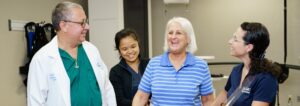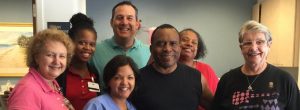Brooks Research Expertise Gains National Visibility Through StrokeNet

Back to physical health resource hub
Research is a huge part of the Brooks health system. The Brooks Clinical Research Center is transforming rehabilitation with innovations in science, technology and care through its community of researchers, rehabilitation professionals and patients. Previous issues of Beyond have showcased various studies Brooks has conducted to generate better outcomes in cases of stroke, spinal cord injuries, brain injuries and chronic pain, as well as highlighting the many awards our researchers and clinicians have earned for their work.
Brooks has taken its research expertise to the national level as a member of the National Institutes of Health (NIH) StrokeNet network. Raine Osborne, PT, DPT, EdD, FAAOMPT is Director of Research at Brooks. “High-impact research is our goal,” said Dr. Osborne. “Being a part of StrokeNet is another mechanism to do that, contributing and having access to large, multi-site national trials. It recognizes Brooks as an institution that can play on that stage and as an institution that makes those kinds of contributions.”
What is StrokeNet?
The National Institute of Neurological Disorders and Stroke (NINDS), part of the U.S. National Institutes of Health (NIH), established StrokeNet in 2013. As stated on its website, StrokeNet’s purpose is to “conduct small and large clinical trials and research studies to advance acute stroke treatment, stroke prevention, and recovery and rehabilitation following a stroke across the lifespan. This network of 27 regional centers across the U.S., which involves approximately 500 hospitals in the U.S., is designed to serve as the infrastructure and pipeline for exciting new potential treatments for patients with stroke and those at risk for stroke.” Brooks is in the Florida region, working with the Florida Regional Coordinating Center at the University of Miami Miller School of Medicine.
Kenneth Ngo, MD, Medical Director of Brooks Rehabilitation Hospital – University Campus and Parag Shah, MD, Medical Director of our new Brooks Rehabilitation Hospital – Bartram Campus have both been site principal investigators for StrokeNet studies. “At Brooks, we always want to be part of the cutting-edge research to explore possibilities, to deliver care for patients to help them improve quicker, faster, better,” said Dr. Ngo. “Being part of StrokeNet allows us to be part of the science to push that envelope.” Dr. Shah said, “StrokeNet helps establish Brooks as being a leader in research. It shows we have that mentality where we’re always seeking out what’s going to be best for our patients.”
Brooks’ StrokeNet participation, to date
Brooks has been an active participant and contributor in two StrokeNet studies, with more studies in the pipeline.
-
- The first study, which is now closed, was “Efficacy of Home-Based Telerehabilitation vs. In-Clinic Therapy for Adults After Stroke: A Randomized Clinical Trial.” The issue addressed arose from the fact that many stroke patients, upon going home, don’t receive all the rehabilitation they could because of situations like limited access to therapists, difficulty with transportation to rehab sites, rehab costs, and overall limited knowledge about stroke.
The study set out to determine whether a comprehensive in-home telehealth therapy program could be as effective as in-clinic rehabilitation. In the study, 124 stroke survivors underwent six weeks of intensive arm motor therapy, with half going to traditional, supervised in-clinic therapy and half receiving the rehabilitation treatment through a supervised, video-conferenced telemedicine system.
Dr. Ngo was a co-investigator and co-author of the study. “We found that patients receiving activity-based training at home, with guidance via telemedicine, had substantial gains in arm motor function similar to traditional in-clinic therapy. This is a significant finding for post-stroke survivors who have difficulty getting to outpatient therapy centers. The success of this study solidified Brooks as a major research center in the StrokeNet network.”
- The first study, which is now closed, was “Efficacy of Home-Based Telerehabilitation vs. In-Clinic Therapy for Adults After Stroke: A Randomized Clinical Trial.” The issue addressed arose from the fact that many stroke patients, upon going home, don’t receive all the rehabilitation they could because of situations like limited access to therapists, difficulty with transportation to rehab sites, rehab costs, and overall limited knowledge about stroke.
-
- Brooks is the top recruiting site for the second study, a five-year, ongoing program called “SleepSMART – Sleep for Stroke Management and Recovery Trial.” SleepSMART builds on prior studies that showed a clear association between obstructive sleep apnea (OSA) and poorer recovery outcomes after stroke, as well as recurrent strokes. The study will see if early treatment of OSA with positive airway pressure after stroke) reduces recurrent stroke and provides for overall better outcomes. Dr. Ngo and Dr. Shah are the site principal investigators, and Taisiya Matev is the site study coordinator.
Dr. Shah said, “What typically happens now is that a stroke patient suspected of having OSA is discharged home and expected to manage it on their own. And some patients might, and some patients might not. With this study, if we’re able to show that this needs to be taken care of sooner rather than later, then the thought is this is something you’ll see hospitals start addressing with their patients before they leave. You’re standardizing care, but you’re also expediting care by having data that shows that this really could make a difference, improve patient outcomes, and reduce morbidity and mortality.”
- Brooks is the top recruiting site for the second study, a five-year, ongoing program called “SleepSMART – Sleep for Stroke Management and Recovery Trial.” SleepSMART builds on prior studies that showed a clear association between obstructive sleep apnea (OSA) and poorer recovery outcomes after stroke, as well as recurrent strokes. The study will see if early treatment of OSA with positive airway pressure after stroke) reduces recurrent stroke and provides for overall better outcomes. Dr. Ngo and Dr. Shah are the site principal investigators, and Taisiya Matev is the site study coordinator.
Additional benefits – all around
Dr. Osborne sees other major benefits for StrokeNet research at Brooks. “StrokeNet is the big leagues in terms of research. These are well-run and well-designed trials. The system that’s in place, how the studies are conducted are all just really solid science. As a research administrator, it’s really interesting to see their infrastructure and how they do things – and then pull those concepts into our own research processes to make our own programs better. Additionally, a benefit of big studies like these is the opportunity for clinicians to be a part of the research process. They’re now working for something beyond the top care they provide their patients every day – they’re contributing to improving care for patients well into the future. That’s a benefit that’s perhaps overlooked.”
Making sure it all runs smoothly
There are a lot of moving parts when it comes to large studies, and this is where Taisiya Matev, BHS, CCRP, Clinical Research Coordinator for Brooks Rehabilitation Clinical Research Center, helps Brooks shine. As a study coordinator, she’s the primary contact with StrokeNet, making sure that things are running well, managing all of the administrative pieces, ensuring that studies stay on track and on protocol, and coordinating the daily clinical trial activities.
Another facet Matev helps with is recruiting patients into studies – this is obviously critical to the success of those studies. Brooks was a later site to join the Telerehabilitation study, but then became one the fastest growing sites for adding participants. For the SleepSMART study, Brooks has been leading by far as the top recruiting site – out of 110 sites nationally – since the study first launched. “Because of Brooks’ culture, we are successful,” said Matev. “You need to care about your participant’s wellbeing, and when enrolling patients in clinical trials you want to provide them with the opportunity to participate in research that best aligns with their goals for recovery. Recognizing participant’s efforts and thanking them for playing an essential role in the study is another important component of our Sleep SMART success.”


